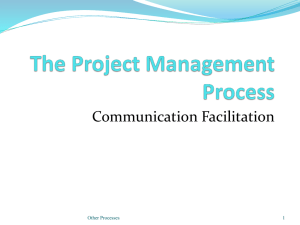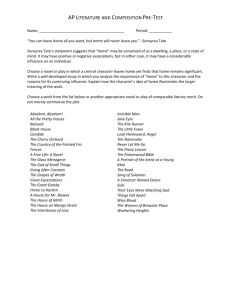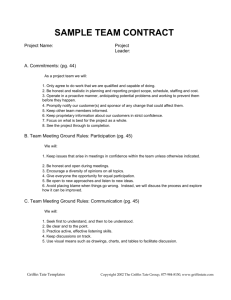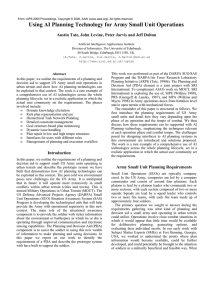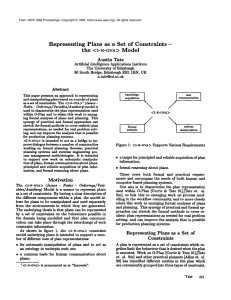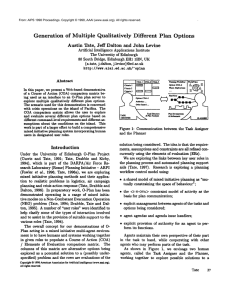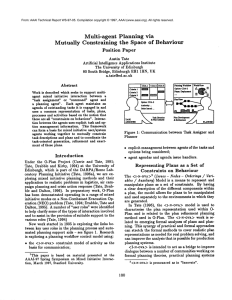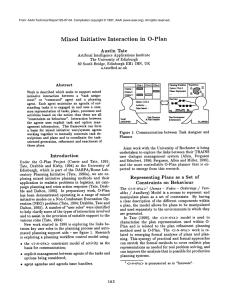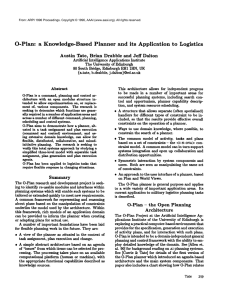O-Plan: a Web-based AI Planning Agent
advertisement
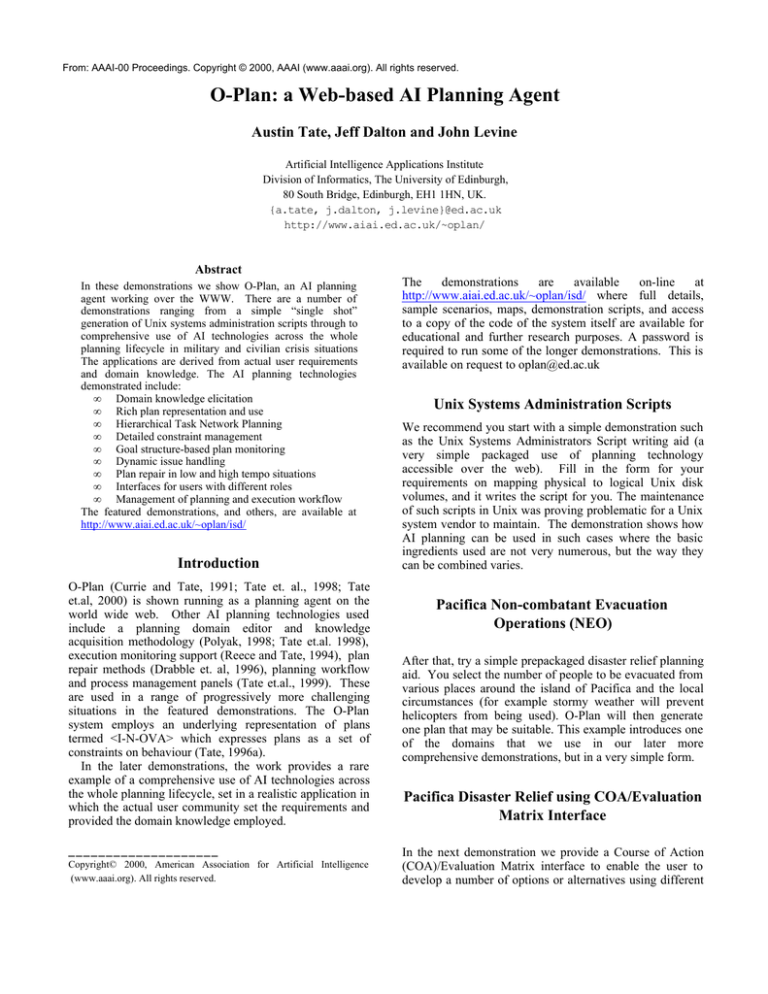
From: AAAI-00 Proceedings. Copyright © 2000, AAAI (www.aaai.org). All rights reserved.
O-Plan: a Web-based AI Planning Agent
Austin Tate, Jeff Dalton and John Levine
Artificial Intelligence Applications Institute
Division of Informatics, The University of Edinburgh,
80 South Bridge, Edinburgh, EH1 1HN, UK.
{a.tate, j.dalton, j.levine}@ed.ac.uk
http://www.aiai.ed.ac.uk/~oplan/
Abstract
In these demonstrations we show O-Plan, an AI planning
agent working over the WWW. There are a number of
demonstrations ranging from a simple “single shot”
generation of Unix systems administration scripts through to
comprehensive use of AI technologies across the whole
planning lifecycle in military and civilian crisis situations
The applications are derived from actual user requirements
and domain knowledge. The AI planning technologies
demonstrated include:
•
Domain knowledge elicitation
•
Rich plan representation and use
•
Hierarchical Task Network Planning
•
Detailed constraint management
•
Goal structure-based plan monitoring
•
Dynamic issue handling
•
Plan repair in low and high tempo situations
•
Interfaces for users with different roles
•
Management of planning and execution workflow
The featured demonstrations, and others, are available at
http://www.aiai.ed.ac.uk/~oplan/isd/
Introduction
O-Plan (Currie and Tate, 1991; Tate et. al., 1998; Tate
et.al, 2000) is shown running as a planning agent on the
world wide web. Other AI planning technologies used
include a planning domain editor and knowledge
acquisition methodology (Polyak, 1998; Tate et.al. 1998),
execution monitoring support (Reece and Tate, 1994), plan
repair methods (Drabble et. al, 1996), planning workflow
and process management panels (Tate et.al., 1999). These
are used in a range of progressively more challenging
situations in the featured demonstrations. The O-Plan
system employs an underlying representation of plans
termed <I-N-OVA> which expresses plans as a set of
constraints on behaviour (Tate, 1996a).
In the later demonstrations, the work provides a rare
example of a comprehensive use of AI technologies across
the whole planning lifecycle, set in a realistic application in
which the actual user community set the requirements and
provided the domain knowledge employed.
____________________
Copyright© 2000, American Association for Artificial Intelligence
(www.aaai.org). All rights reserved.
The
demonstrations
are
available
on-line
at
http://www.aiai.ed.ac.uk/~oplan/isd/ where full details,
sample scenarios, maps, demonstration scripts, and access
to a copy of the code of the system itself are available for
educational and further research purposes. A password is
required to run some of the longer demonstrations. This is
available on request to oplan@ed.ac.uk
Unix Systems Administration Scripts
We recommend you start with a simple demonstration such
as the Unix Systems Administrators Script writing aid (a
very simple packaged use of planning technology
accessible over the web). Fill in the form for your
requirements on mapping physical to logical Unix disk
volumes, and it writes the script for you. The maintenance
of such scripts in Unix was proving problematic for a Unix
system vendor to maintain. The demonstration shows how
AI planning can be used in such cases where the basic
ingredients used are not very numerous, but the way they
can be combined varies.
Pacifica Non-combatant Evacuation
Operations (NEO)
After that, try a simple prepackaged disaster relief planning
aid. You select the number of people to be evacuated from
various places around the island of Pacifica and the local
circumstances (for example stormy weather will prevent
helicopters from being used). O-Plan will then generate
one plan that may be suitable. This example introduces one
of the domains that we use in our later more
comprehensive demonstrations, but in a very simple form.
Pacifica Disaster Relief using COA/Evaluation
Matrix Interface
In the next demonstration we provide a Course of Action
(COA)/Evaluation Matrix interface to enable the user to
develop a number of options or alternatives using different
initial conditions or differing objectives and guidance. We
recommend that you start with a simple matrix interface
demonstration for Pacifica Disaster Relief. It does not
need a password. This demonstration introduces the type
of COA/Evaluation Matrix interface we use in most of our
work (ate et.al., 1999), but in a simple single user role
form. You just list the types of problem to be addressed,
give some information about the local circumstances and
time available, then generate a plan in a one shot exercise
(without interacting with the planner in a mixed initiative
mode) and view the results. You can move on and
generate other options with different initial conditions and
different objectives if you wish.
Pacifica Disaster Relief using Multi-user Role
COA/Evaluation Matrix Interface
If you feel comfortable with the earlier demonstrations and
have a little more time available (15 minutes is suggested),
then move on to one of the demonstrations needing a
password. The COA/Evaluation matrix interface in this
more comprehensive Pacifica Island Disaster Recovery
demonstration allows for multiple users with different roles
to work together with automated planning agent in a mixed
initiative fashion. User roles can be as commander/task
assigner or planner. The Planning Process Panel (Tate
et.al. 1999) interface supports the coordination of the
planning process between users and the automated
planning agent in the development of multiple options at
various stages of generation and evaluation.
You do not need to type in a session name unless several
users want to engage in collaborative development of the
options (in which case they should select different user
roles from those available in the pull down menu, and type
in a session name which they have agreed).
US Army Small Unit Operations using Multiuser Role COA/Evaluation Matrix Interface
In this final demonstration, we have identified the stages in
the overall Small Unit Operations SUO) command,
planning and execution process at US Army company level
from receipt of mission through to a successful outcome
and after-action activities (US Army, 1999). Within this
process there are opportunities for a range of planning and
decision aids, all facilitated by a common approach to
representing the objectives and plans involved.
The demonstration (Tate et. al., 2000) addresses all the
phases of the operation. It uses O-Plan and its associated
planning technology to address the whole lifecycle of the
generation and use of plans:
• Domain and initial plan representation
• Deliberative initial planning and generation of
multiple options
•
•
Plan execution monitoring and dynamic repair of
plans
Tailored interfaces for various user roles including
planning process workflow support
Further information of the technology employed in these
demonstrations is available in the references below or at
the O-Plan Home Page (http://www.aiai.ed.ac.uk/~oplan/).
Acknowledgements
The O-Plan project is sponsored by the Defense Advanced
Research Projects Agency (DARPA) and the U.S. Air Force
Research Laboratory (AFRL) via the Planning Initiative (Tate,
1996b) under grant number F30602-99-1-0024. The U.S.
Government and the University of Edinburgh are authorized to
reproduce and distribute reprints for their purposes
notwithstanding any copyright annotation hereon.
References
Currie, K. and Tate, A., 1991, O-Plan: the Open Planning
Architecture, Artificial Intelligence, Vol. 52, pp.49-86, Elsevier,
1991.
Polyak, S., 1998, A Common Process Methodology for
Engineering Process Domains, Proceedings of the Systems
Engineering for Business Process Change (SEBPC) workshop,
University of Ulster, March 1999.
Reece, G., and Tate, A., 1994, Synthesizing Protection Monitors
from Causal Structure, Proceedings of the Second International
Conference on Planning System, Chicago, June, AAAI Press.
Tate, A., 1996a, Representing Plans as a Set of Constraints – the
<I-N-OVA> Model, in Proceedings of the Third International
Conference on Artificial Intelligence Planning Systems,
Edinburgh, UK.
Tate, A. (ed.), 1996b, Advanced Planning Technology:
Technological Achievements of the ARPA/Rome Laboratory
Planning Initiative, AAAI Press.
Tate, A., Dalton, J., and Levine, J., 1998, Generation of multiple
qualitatively different plans, Proceedings of the 4th International
Conference on AI Planning System, Pittsburgh, USA.
Tate, A., Levine, J., Dalton, J., and Aitken, S., 1999, O-P3:
Supporting the Planning Process using Open Planning Process
Panels, Proceedings of the AAAI Workshop on Agent Based
Systems in the Business Context, AAAI-Press WS-99-02.
Tate, A., Levine, J., Jarvis, P., and Dalton, J., 2000, Using AI
Planning Technology for Army Small Unit Operations,
Proceedings of the Fifth International Conference on Artificial
Intelligence Planning Systems (AIPS_2000), May 2000.
Tate, A., Polyak, S., Jarvis, P., 1998, TF Method: An Initial
Framework for Modeling and Analyzing Planning Domains,
Proceedings of the AIPS-98 workshop on Knowledge Engineering
and Acquisition for Planning: Bridging Theory and Practice,
AAAI Technical Report WS-98-03.
US Army, 1999, Center for Army Lessons Learned, Virtual
Research Library, http://call.army.mil
